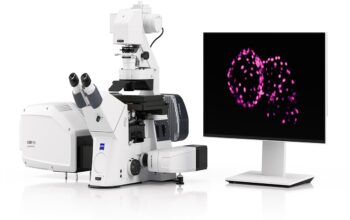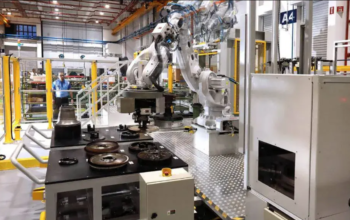The automotive industry faces constant pressure to reduce costs and increase efficiency like other manufacturing segments. Over the last several decades, the limitation of traditional tools to design and inspect automotive parts pose a challenge to its fast-paced growth.
Issues arising on several levels:
- Hard to obtain CAD files of complex parts for further design
- Traditional tools to inspect automotive parts are time-consuming
- Hard to verify the dimensions of large parts
The designers and manufacturers in the automotive industry often struggle with challenges that hinder development and increase unforeseen costs. The increasing use of digital technology like 3D scanning in design, production, and inspection has yielded enormous benefits in quality and efficiency.
To be practical for the application in automotive industry, a 3D scanning technique must embody some features. These features includes high efficiency, high precision, a large measurement volume, the ability to capture 3D data from complex surfaces or hard-to-reach areas, high adaptability to dark or reflective finishes.
The following cases show us how Scantech’s 3D scanners can be applied in product development and inspection of automotive industry.
Reverse engineering
Case 1: Design of Automobile seat
Reverse engineering is a process to measure a product and reconstruct it as a 3D model for product design when there is no original drawing at hand.

Traditionally, engineers and designers use 3D model software to create basic sketches and then transfer them to reverse engineering software to design a new component. The CAD module adds trouble-some steps during such designs. The conventional computer-aided design takes an average of three months to complete design, which is not acceptable for modern automakers to maintain a competitive advantage.
Three-dimensional scanning can be used as an input for digital models thanks to its ease acquisition of geometries and dimensions. It can capture complex geometries more easily and efficiently in comparison to creating a model in CAD software. This aids in improving the quality of the product.

Advantages of 3D scanning in automobile seat design
With 3D scanning, technicians rapidly obtained the 3D data of automobile seats with a measurement rate of 480,000 measurements/s. The convention from a product to a CAD file was accelerated as the data is efficiently captured. It also saved time for editing data. The 3D model was available to both the design and engineer teams so that they can communicate with each other seamlessly as they can access to complete 3D data.
Automobile Parts Inspection
Case 2: Inspection of a car hood
The car hood is like a rib cage that protects the engine, circuit, and other important components that make a car to urn. However, it is usually hard to assemble the hood due to the deviations of welding and parts produced. Inspection, therefore, is essential to ensure high-quality manufacturing.

Challenges of inspection
The car hood is large and traditional measurement methods like CMM check a few spots of it, which is not accurate enough. The contact measurement is also time-consuming as it has to probe the parts at one point one time. A 3D inspection device that can deliver accurate results in high efficiency becomes necessary.
With the help of 3D inspection, automakers will get the deviation values between the finished car hood and CAD drawing. Moreover, its holes and mounting fasteners can also be accurately measured so that automakers will know whether the installation requirements are met.
The scanning process
ScanTech uses a handheld 3D laser scanner KSCAN to measure the large surface , holes, and mounting fasteners of the car hood. For complex areas, our in-house 3D scan software ScanViewer improved scanning precision by adjusting the parameters among points.

Advantages
- Easily and accurately measure the large surface
- No damages caused by non-contact measurement
- Fast measuring speed & flexible operation
- Scanning reflective surface without spraying powders
Automobile Manufacturing Mold Inspection
Case 3: Inspection of silicone mold for interior parts
The mold for producing automobile carbon-fiber interior parts is generally made in silica gel. Silica gel is an amorphous and porous form of silicon dioxide and it is extensible. With better fluidity and low viscosity, it suits well for making molds. This kind of product-relevant mold can be measured and checked to identify potential errors at an early stage of manufacturing.

Challenges of inspection
Before the emergence of a practical and efficient measurement tool, manufacturers do not inspect silicone molds. They have to inspect products after production, which brings expensive costs in terms of time and defective products.

Disadvantages of traditional inspection tools
Traditional inspection tool includes CMM, robotic arm with a sensor, blue light 3D scanner, and manual tools like a straight ruler. CMM, basically does the measurement by probing the workpiece, fails to measure the silicone mold. It is because silicone mold can be easily deformed during the measurement as it is soft. The condition also applies to the inspection conducted by an industrial robotic arm with a triangulation sensor. When it comes to measuring the mold with a blue light 3D scanner, one has to clean the surface and apply developer spray before scanning. The developer has to be cleaned with alcohol or other solvents, but it may corrode the silicone mold.
How can handheld 3D scanner SIMSCAN 30 help
Handheld and portable 3D scanner SIMSCAN 30 performed non-contact scanning for silicone mold. In this way, the deformation occurs during the measurement was no longer a problem. When scanning, technicians don’t have to apply developer spray to the object as SIMSCAN has high adaptability to different finishes. With a measurement rate of 2,020,000 measurements/s, SIMSCAN captured precise data and represented the mold in point clouds ready for inspection.

Still have questions? Ask the 3D scanning experts!
At this point, you may still have questions about how 3D scanning can be used in your daily work and how can it benefit your business. Don’t hesitate to ask our experts for more information. Our professional and dedicated teams are willing to help you find our best 3D solutions for your business. Contact us today.









